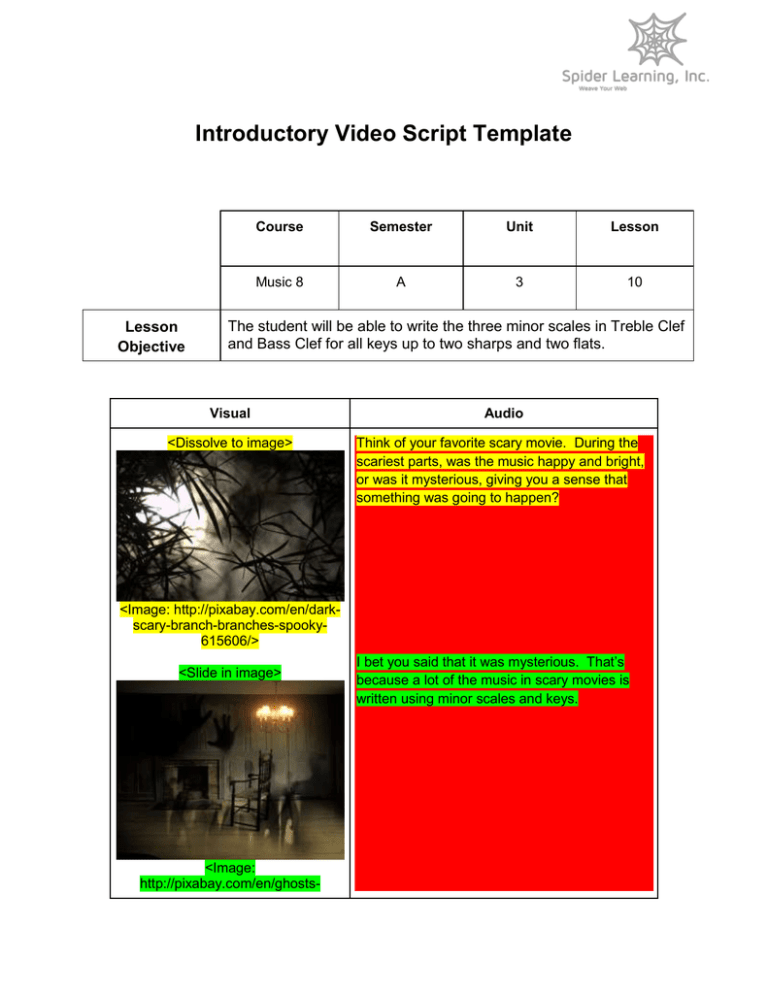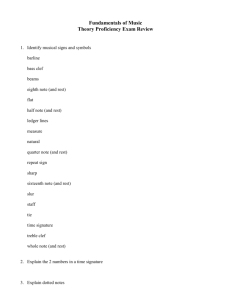Introductory Video Script Template
advertisement

Introductory Video Script Template Lesson Objective Course Semester Unit Lesson Music 8 A 3 10 The student will be able to write the three minor scales in Treble Clef and Bass Clef for all keys up to two sharps and two flats. Visual Audio <Dissolve to image> Think of your favorite scary movie. During the scariest parts, was the music happy and bright, or was it mysterious, giving you a sense that something was going to happen? <Image: http://pixabay.com/en/darkscary-branch-branches-spooky615606/> <Slide in image> <Image: http://pixabay.com/en/ghosts- I bet you said that it was mysterious. That’s because a lot of the music in scary movies is written using minor scales and keys. gespenter-spooky-horror-572038/> <Fade in Image> In this lesson, we will be building minor scales with varied key signatures. <Image:http://www.morguefile.com/a rchive/display/943871> <Dissolve in Text> <TEXT: (Fly in Text as it is read) Minor Scale Facts: A minor scale is a diatonic scale. There are three types of minor scales: natural, harmonic and melodic. A natural minor scale contains the same key signature as its relative major, with no alterations.> <Swirl in Image> A minor scale is a diatonic (die-a-tonic) scale. There are three types of minor scales, natural, harmonic and melodic. A natural minor scale contains the same key signature as its relative major, with no alterations. A harmonic minor scale contains a raised 7th. <Image: Image1_L10> <Bounce in Image> A melodic minor scale contains a raised 6th and 7th ascending and returns to natural minor descending. <Image: Image2_L10> <Dissolve in Image, use reference image to create first two key signatures in left row, and second two in right row> The Key Signatures we will be using to build these scales are up to the first two sharps and flats. <Reference Image:http://commons.wikimedia. org/wiki/File:Key_Signature_Flash cards.pdf> <Fade in Text> <TEXT: C, G, D, F, and Bb> <Dissolve in Image> <Highlight respective keys> In major these keys are: C, G, D, F and Bb (B flat) All of these key signatures are at the top of the circle of fifths. <Image:http://commons.wikimedia .org/wiki/File:Circle_fifths.svg> <Fade in Image> <Image3_L10> <Highlight a> Figure out the 6th scale degree of each of these major scales. The sixth scale degree of C is a. The sixth scale degree of G is e. <Highlight e> <Highlight b> <Highlight d> The sixth scale degree of D is b. The sixth scale degree of F is d. The sixth scale degree of Bb is g. <Highlight g> <Dissolve in Image> You can then build your minor scales using the same key signature. <Image:http://commons.wikimedia .org/wiki/File:Circle_fifths.svg> Here is what they will look like: <Dissolve in Image> <Reference Image> <Reference image:http://www.hearandplay.co m/p88.ht75.gif> a minor <Highlight a minor> <Highlight e minor> e minor <Highlight b minor> b Minor <Highlight d minor> d minor <Highlight g minor> g minor Another way the build a minor scale is to use intervals. <Fade in Text> <TEXT: Interval Method> <Dissolve in Image> <Image5_L10> Let’s say someone told you to build a minor scale on g and you had to include accidentals. <Bounce in Text> <TEXT: Minor Scale Intervals:Whole, Half, Whole, Whole, Half, Whole, Whole> The intervals for the natural minor scale are Whole, Half, Whole, Whole, Half, Whole, Whole <Bounce in Image> <Image6_L10> <Highlight flats (b)> <Dissolve to Image> Start at G and build the steps going up to the next g. Now you can see what the accidentals are in natural minor and figure out the key signature. No matter what minor scale you build, you must build the natural minor before the harmonic or melodic. <Image: Image7_L10> <Dissolve to Image> In addition, we will learn how to build both treble and bass (base) clef scales. Let’s review the lines and spaces of the treble and bass clef scales. <Image:http://commons.wikimedia.or g/wiki/File:Piano_staff.PNG> <Fade in Text> The treble clef spaces are F, A, C, E. A good way to remember this is the word face. <TEXT: FACE> <Fade in Text> The treble clef lines are E, G, B, D, F. A good <TEXT: Every Good Boy Does Fine> way to remember this is Every Good Boy Does Fine The bass clef spaces are A, C, E, G. A good <Dissolve in Text> way to remember this is All Cows Eat Grass. <TEXT: All Cows Eat Grass> The bass clef lines are G, B, D F, A. A good <Dissolve in Text> <TEXT: Good Boys Do Fine Always> way to remember this is Good Boys Do Fine Always. <Swirl in Image> Let’s take a look at e minor. This is how e <Image8_L10> minor looks in treble clef. <Swirl in Image> <Image9_L10> <Fade in Image> This is how e minor looks in bass clef. Minor tonality is used frequently in classical compositions. <Image: http://pixabay.com/en/music-clefnotenblatt-texture-665603/> <Dissolve in Image> Here is a Rondo in g minor by Antonin (ahn-toenin) Dvorak (deh-vor-dzahk). Listen for those mysterious qualities of minor music. <Narrator pauses for 45 seconds as audio is played> <Please play audio clip from 0:00-0:30> <https://musopen.org/music/download/7955/> <Image:http://commons.wikimedia.or g/wiki/File:NSRW_Antonin_Dvorak.s vg>






